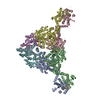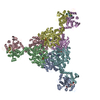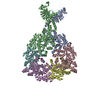[English] 日本語
 Yorodumi
Yorodumi- EMDB-39951: Raw consensus map of type III CRISPR-associated deaminase in comp... -
+ Open data
Open data
- Basic information
Basic information
| Entry |  | |||||||||
|---|---|---|---|---|---|---|---|---|---|---|
| Title | Raw consensus map of type III CRISPR-associated deaminase in complex cA4 | |||||||||
 Map data Map data | ||||||||||
 Sample Sample |
| |||||||||
 Keywords Keywords | defense system / deaminase / IMMUNE SYSTEM | |||||||||
| Biological species |  Limisphaera ngatamarikiensis (bacteria) Limisphaera ngatamarikiensis (bacteria) | |||||||||
| Method | single particle reconstruction / cryo EM / Resolution: 2.42 Å | |||||||||
 Authors Authors | Chen MR / Li ZX / Xiao YB | |||||||||
| Funding support |  China, 1 items China, 1 items
| |||||||||
 Citation Citation |  Journal: Science / Year: 2025 Journal: Science / Year: 2025Title: Antiviral signaling of a type III CRISPR-associated deaminase. Authors: Yutao Li / Zhaoxing Li / Purui Yan / Chenyang Hua / Jianping Kong / Wanqian Wu / Yurong Cui / Yan Duan / Shunxiang Li / Guanglei Li / Shunli Ji / Yijun Chen / Yucheng Zhao / Peng Yang / ...Authors: Yutao Li / Zhaoxing Li / Purui Yan / Chenyang Hua / Jianping Kong / Wanqian Wu / Yurong Cui / Yan Duan / Shunxiang Li / Guanglei Li / Shunli Ji / Yijun Chen / Yucheng Zhao / Peng Yang / Chunyi Hu / Meiling Lu / Meirong Chen / Yibei Xiao /   Abstract: Prokaryotes have evolved diverse defense strategies against viral infection, including foreign nucleic acid degradation by CRISPR-Cas systems and DNA and RNA synthesis inhibition through nucleotide ...Prokaryotes have evolved diverse defense strategies against viral infection, including foreign nucleic acid degradation by CRISPR-Cas systems and DNA and RNA synthesis inhibition through nucleotide pool depletion. Here, we report an antiviral mechanism of type III CRISPR-Cas-regulated adenosine triphosphate (ATP) depletion in which ATP is converted into inosine triphosphate (ITP) by CRISPR-Cas-associated adenosine deaminase (CAAD) upon activation by either cA or cA, followed by hydrolysis into inosine monophosphate (IMP) by Nudix hydrolase, ultimately resulting in cell growth arrest. The cryo-electron microscopy structures of CAAD in its apo and activated forms, together with biochemical evidence, revealed how cA or cA binds to the CRISPR-associated Rossmann fold (CARF) domain and abrogates CAAD autoinhibition, inducing substantial conformational changes that reshape the structure of CAAD and induce its deaminase activity. Our results reveal the mechanism of a CRISPR-Cas-regulated ATP depletion antiviral strategy. | |||||||||
| History |
|
- Structure visualization
Structure visualization
| Supplemental images |
|---|
- Downloads & links
Downloads & links
-EMDB archive
| Map data |  emd_39951.map.gz emd_39951.map.gz | 258.4 MB |  EMDB map data format EMDB map data format | |
|---|---|---|---|---|
| Header (meta data) |  emd-39951-v30.xml emd-39951-v30.xml emd-39951.xml emd-39951.xml | 14.4 KB 14.4 KB | Display Display |  EMDB header EMDB header |
| FSC (resolution estimation) |  emd_39951_fsc.xml emd_39951_fsc.xml | 16.9 KB | Display |  FSC data file FSC data file |
| Images |  emd_39951.png emd_39951.png | 36.1 KB | ||
| Filedesc metadata |  emd-39951.cif.gz emd-39951.cif.gz | 4.2 KB | ||
| Others |  emd_39951_half_map_1.map.gz emd_39951_half_map_1.map.gz emd_39951_half_map_2.map.gz emd_39951_half_map_2.map.gz | 474.8 MB 474.8 MB | ||
| Archive directory |  http://ftp.pdbj.org/pub/emdb/structures/EMD-39951 http://ftp.pdbj.org/pub/emdb/structures/EMD-39951 ftp://ftp.pdbj.org/pub/emdb/structures/EMD-39951 ftp://ftp.pdbj.org/pub/emdb/structures/EMD-39951 | HTTPS FTP |
-Validation report
| Summary document |  emd_39951_validation.pdf.gz emd_39951_validation.pdf.gz | 901.6 KB | Display |  EMDB validaton report EMDB validaton report |
|---|---|---|---|---|
| Full document |  emd_39951_full_validation.pdf.gz emd_39951_full_validation.pdf.gz | 901.2 KB | Display | |
| Data in XML |  emd_39951_validation.xml.gz emd_39951_validation.xml.gz | 26 KB | Display | |
| Data in CIF |  emd_39951_validation.cif.gz emd_39951_validation.cif.gz | 34.2 KB | Display | |
| Arichive directory |  https://ftp.pdbj.org/pub/emdb/validation_reports/EMD-39951 https://ftp.pdbj.org/pub/emdb/validation_reports/EMD-39951 ftp://ftp.pdbj.org/pub/emdb/validation_reports/EMD-39951 ftp://ftp.pdbj.org/pub/emdb/validation_reports/EMD-39951 | HTTPS FTP |
-Related structure data
- Links
Links
| EMDB pages |  EMDB (EBI/PDBe) / EMDB (EBI/PDBe) /  EMDataResource EMDataResource |
|---|
- Map
Map
| File |  Download / File: emd_39951.map.gz / Format: CCP4 / Size: 512 MB / Type: IMAGE STORED AS FLOATING POINT NUMBER (4 BYTES) Download / File: emd_39951.map.gz / Format: CCP4 / Size: 512 MB / Type: IMAGE STORED AS FLOATING POINT NUMBER (4 BYTES) | ||||||||||||||||||||||||||||||||||||
|---|---|---|---|---|---|---|---|---|---|---|---|---|---|---|---|---|---|---|---|---|---|---|---|---|---|---|---|---|---|---|---|---|---|---|---|---|---|
| Projections & slices | Image control
Images are generated by Spider. | ||||||||||||||||||||||||||||||||||||
| Voxel size | X=Y=Z: 0.96 Å | ||||||||||||||||||||||||||||||||||||
| Density |
| ||||||||||||||||||||||||||||||||||||
| Symmetry | Space group: 1 | ||||||||||||||||||||||||||||||||||||
| Details | EMDB XML:
|
-Supplemental data
-Half map: #1
| File | emd_39951_half_map_1.map | ||||||||||||
|---|---|---|---|---|---|---|---|---|---|---|---|---|---|
| Projections & Slices |
| ||||||||||||
| Density Histograms |
-Half map: #2
| File | emd_39951_half_map_2.map | ||||||||||||
|---|---|---|---|---|---|---|---|---|---|---|---|---|---|
| Projections & Slices |
| ||||||||||||
| Density Histograms |
- Sample components
Sample components
-Entire : CRISPR-associated adenosine deaminase
| Entire | Name: CRISPR-associated adenosine deaminase |
|---|---|
| Components |
|
-Supramolecule #1: CRISPR-associated adenosine deaminase
| Supramolecule | Name: CRISPR-associated adenosine deaminase / type: complex / ID: 1 / Parent: 0 |
|---|---|
| Source (natural) | Organism:  Limisphaera ngatamarikiensis (bacteria) Limisphaera ngatamarikiensis (bacteria) |
-Experimental details
-Structure determination
| Method | cryo EM |
|---|---|
 Processing Processing | single particle reconstruction |
| Aggregation state | particle |
- Sample preparation
Sample preparation
| Buffer | pH: 7.5 |
|---|---|
| Vitrification | Cryogen name: ETHANE |
- Electron microscopy
Electron microscopy
| Microscope | TFS KRIOS |
|---|---|
| Image recording | Film or detector model: FEI FALCON IV (4k x 4k) / Average electron dose: 40.0 e/Å2 |
| Electron beam | Acceleration voltage: 300 kV / Electron source:  FIELD EMISSION GUN FIELD EMISSION GUN |
| Electron optics | Illumination mode: FLOOD BEAM / Imaging mode: BRIGHT FIELD / Nominal defocus max: 2.4 µm / Nominal defocus min: 0.8 µm |
| Experimental equipment |  Model: Titan Krios / Image courtesy: FEI Company |
 Movie
Movie Controller
Controller





















 Z (Sec.)
Z (Sec.) Y (Row.)
Y (Row.) X (Col.)
X (Col.)





































